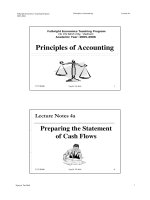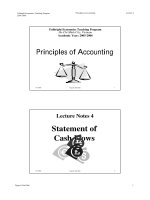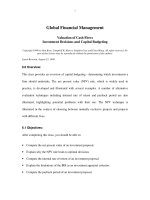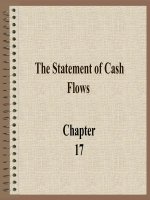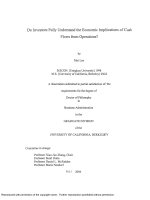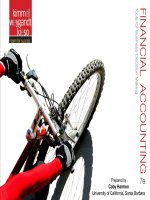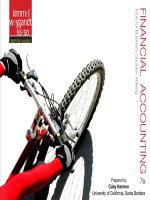estimation of cash flows
Bạn đang xem bản rút gọn của tài liệu. Xem và tải ngay bản đầy đủ của tài liệu tại đây (143.8 KB, 33 trang )
2-1
Chapter 12
Capital
Capital Budgeting
Budgeting
and
and Estimating
Estimating
Cash
Cash Flows
Flows
2-2
What
What is
is
Capital
Capital Budgeting?
Budgeting?
The process of identifying,
analyzing, and selecting
investment projects whose
returns (cash flows) are
expected to extend beyond
one year.
2-3
The
The Capital
Capital
Budgeting
Budgeting Process
Process
Generate investment proposals
consistent with the firm’s strategic
objectives.
Estimate after-tax incremental
operating cash flows for the
investment projects.
Evaluate project incremental cash
flows.
2-4
The
The Capital
Capital
Budgeting
Budgeting Process
Process
Select projects based on a valuemaximizing acceptance criterion.
Reevaluate implemented
investment projects continually
and perform postaudits for
completed projects.
2-5
Classification
Classification of
of Investment
Investment
Project
Project Proposals
Proposals
1. New products or expansion of
existing products
2. Replacement of existing equipment or
buildings
3. Research and development
4. Exploration
5. Other (e.g., safety or pollution related)
2-6
Screening
Screening Proposals
Proposals
and
and Decision
Decision Making
Making
1. Section Chiefs
2. Plant Managers
3. VP for Operations
4. Capital Expenditures
Committee
5. President
6. Board of Directors
Advancement
to the next
level depends
on cost
and strategic
importance.
2-7
Estimating
Estimating After-Tax
After-Tax
Incremental
Incremental Cash
Cash Flows
Flows
Basic characteristics of
relevant project flows
Cash (not accounting income) flows
Operating (not financing) flows
After-tax flows
Incremental flows
2-8
Estimating
Estimating After-Tax
After-Tax
Incremental
Incremental Cash
Cash Flows
Flows
Principles that must be adhered
to in the estimation
Ignore sunk costs
Include opportunity costs
Include project-driven changes in
working capital net of spontaneous
changes in current liabilities
Include effects of inflation
2-9
Tax Considerations
and Depreciation
Depreciation represents the systematic
allocation of the cost of a capital asset
over a period of time for financial
reporting purposes, tax purposes, or
both.
Generally, profitable firms prefer to use
an accelerated method for tax
reporting purposes (MACRS).
2-10
Depreciation and the
MACRS Method
Everything else equal, the greater the
depreciation charges, the lower the
taxes paid by the firm.
Depreciation is a noncash expense.
Assets are depreciated (MACRS) on one
of eight different property classes.
Generally, the half-year convention is
used for MACRS.
2-11
MACRS Sample Schedule
Recovery
Year
1
2
3
4
5
6
7
8
Property Class
3-Year
5-Year
33.33%
20.00%
44.45
32.00
14.81
19.20
7.41
11.52
11.52
5.76
7-Year
14.29%
24.49
17.49
12.49
8.93
8.92
8.93
4.46
2-12
Calculating the
Incremental Cash Flows
Initial cash outflow -- the initial net cash
investment.
Interim incremental net cash flows -those net cash flows occurring after the
initial cash investment but not including
the final period’s cash flow.
Terminal-year incremental net cash flows
-- the final period’s net cash flow.
2-13
Initial Cash Outflow
a)
b)
+
Cost of “new” assets
Capitalized expenditures
c)
+
Increased NWC
d)
-
Net proceeds from sale of
“old” asset(s) if replacement
e)
+ (-) Taxes (savings) due to the sale
of “old” asset(s) if replacement
f)
=
Initial cash outflow
2-14
Incremental Cash Flows
a)
Net incr. (decr.) in operating revenue
less (plus) any net incr. (decr.) in
operating expenses, excluding depr.
b)
- (+) Net incr. (decr.) in tax depreciation
c)
=
d)
- (+) Net incr. (decr.) in taxes
e)
=
f)
+ (-) Net incr. (decr.) in tax depr. charges
g)
=
Net change in income before taxes
Net change in income after taxes
Incremental net cash flow for period
Terminal-Year
Incremental Cash Flows
a)
Calculate the incremental net cash
flow for the terminal period
b)
+ (-) Salvage value (disposal/reclamation
costs) of any sold or disposed assets
c)
- (+) Taxes (tax savings) due to asset sale
or disposal of “new” assets
d)
+ (-) Decreased (increased) level of “net”
working capital
e)
=
2-15
Terminal year incremental net cash flow
2-16
Example 1: an Asset Expansion Project
ABC Co. is considering the purchase of a new
equipment. The equipment will cost $90,000 plus
$10,000 for shipping and installation.
Falls under the 3-year MACRS class.
No NWC requirements.
It is forecasted that revenues for the next 4 years :
35167, 36250, 55725, 32,258.
The used equipment will then be sold (scrapped) for
$16,500 at the end of the fourth year, when the project
ends.
It is in the 40% tax bracket.
2-17
Initial Cash Outflow
a)
$90,000
b) +
10,000
c) +
0
d
0 (not a replacement)
-
e) + (-)
f)
0 (not a replacement)
=
$100,000
2-18
Example 1: an Asset
Expansion Project
a)
b)
c)
d)
e)
f)
g)
or
Net C/F
- Depr.
= CF_BT
- Tax
= CF_AT
+ Depr.
Incr. C/F
(a) - (d)
year 1 year 2
35167 36250
33330 44450
1837 (8200)
735 (3280)
1102 (4920)
33330 44450
34432 39530
34432 39530
year 3 year 4
55725 32258
14810
7410
40915 24848
16366
9939
24549 14909
14810
7410
39359 22319
39359 22319
Terminal-Year Incremental C/F
2-19
a)
$22,319 The incremental cash flow
from the previous slide in Year 4.
b) + 16,500
c) -
d) +
6,600
0
e) = $32,219
Salvage Value.
.40*($16,500 - 0) Note, the
asset is fully depreciated at
the end of Year 4.
NWC - Project ends.
Terminal-year incremental
cash flow.
2-20
Summary of Project Net Cash
Flows
Asset Expansion
Year 0
4
Year 1
-$100,000 $34,432
$32,219
Year 2
$39,530
Year 3
$39,359
Year
2-21
Summary of Project
year 1
year 2
year 3
year 4
a)
Net C/F
35167
36250
55725
32258
b)
- Depr.
33330
44450
14810
7410
c)
= CF_BT
1837
(8200)
40915
24848
d)
- Tax
735
(3280)
16366
9939
34432
39530
39359
22319
(a) - (d)
Terminal Year CF = (16,500*.6)=9,900
(100000)
34,432
39,530
32,219
39,359
32,219
Example 2: an Asset Expansion Project
BW
Co. is considering the purchase of a new machine.
The machine will cost $50,000 plus $20,000 for shipping
and installation.
Falls under the 3-year MACRS class.
NWC will rise by $5,000.
FM forecasts that revenues will increase by $110,000 for
each of the next 4 years and will then be sold (scrapped)
for $10,000 at the end of the fourth year, when the project
ends. Operating costs will rise by $70,000 for each of the
next four years.
BW is in the 40% tax bracket.
2-22
2-23
Initial Cash Outflow
a) $50,000
b)+
20,000
c) +
5,000
d)-
0 (not a replacement)
e) + (-)
f) = $75,000
0 (not a replacement)
2-24
Incremental Cash Flows
Year 1
Year 2
Year 3
Year 4
Net C/F
$40,000
$40,000
$40,000
$40,000
b) - Depr.
23,331
31,115
10,367
5,187
c) = CF_BT $16,669
$ 8,885
$29,633
$34,813
6,668
3,554
11,853
13,925
e) = CF_AT $10,001
$ 5,331
$17,780
$20,888
a)
d) - Tax
f)
+
23,331
31,115
10,367
5,187
g)
=
$33,332
$36,446
$28,147
$26,075
Terminal-Year
Incremental Cash Flows
a) $26,075 The incremental cash flow from the
previous slide in Year 4.
b) +
10,000
Salvage Value.
c) 4,000
.40*($10,000 - 0) Note, the asset is
fully depreciated at
the end of Year 4.
d) +
5,000
e) = $37,075
flow.
2-25
NWC - Project ends.
Terminal-year incremental cash


